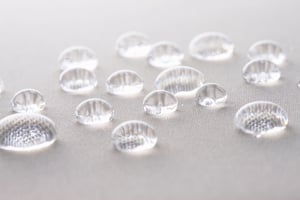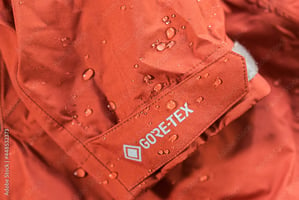Surprisingly few people can properly explain the difference between waterproofing and water...
DWR vs Waterproof: Understanding the Difference
DWR and water resistance are often misunderstood. Discover the key differences between DWR and waterproof to have best choices for your rain jacket.
What is DWR?
DWR stands for Durable Water Repellent. It is a coating applied to fabrics to make them water-repellent. DWR applies a hydrophobic coating to the surface of the fiber, which prevents water from seeping into the fabric and allows water to bead up and roll off. This keeps the fabric dry and prevents it from becoming waterlogged.
DWR is applied to the threads rather than coating the entire fabric, thus maintaining the fabric's breathability. This allows water vapor to escape from the interior of the rain jacket, even when using breathable materials, keeping the wearer comfortable and dry during exercise.
However, it is important to note that DWR does not waterproof fabrics; DWR is often confused with waterproofness, which is a completely different physical phenomenon. I will explain each in detail.
What is Waterproof?
Waterproof refers to the ability of a material to prevent water from passing through it. Unlike DWR, which only repels water, water resistance prevents water from penetrating even under pressure.
Water resistance is a function of some kind of shielding. The shielding may be a coating or a film. In the case of film, the waterproof film is laminated with fabric on top and bottom. The well-known Gore-Tex is in this form. This waterproof film uses advanced technology to keep the wearer dry in heavy rain conditions by allowing water vapor to pass through but not water.
In the case of films (often this film is called a membrane), we must pay attention to the fact that these are laminated. In other words, DWR and water repellency are imparted to different materials, and while DWR is imparted to the outer fabric of the laminated fabric, the water repellency is only on the laminated middle side. In other words, loss of water repellency does not necessarily mean loss of water resistance. This is because they are attached to different materials. Therefore, waterproofness is often maintained as long as there are no holes, tears, or other physical damage or chemical deterioration.
How does DWR work?
DWR works by reducing the surface tension of the fabric, making the force of water droplets to acclimate to the fabric as weak as possible. These are achieved by applying a chemical coating to the yarn surface.
Until now, the chemicals used in DWR coatings have been organo-fluorine compounds (PFCs or PFAS), which are fluoropolymers consisting of fluorine and carbon bonded together. However, the use of organofluorine compounds has been discouraged due to their high persistence in the environment and their tendency to accumulate in living organisms. Therefore, there has been a shift to non-fluorinated DWRs. However, due to their chemical properties, DWR performance is inferior without fluorine, so a different approach is required on the part of users.
It is also important to note that DWR performance is not permanent: DWR coatings do not degrade in their performance simply by being stored without any treatment, but they do peel off with use. Therefore, maintenance such as reapplying DWR that has peeled off is necessary to maintain its effectiveness.
How does Waterproof work?
Waterproof materials work by creating a physical barrier that prevents water molecules from passing through. This barrier can be achieved through various methods, such as laminating multiple layers of fabric, using specialized membranes, or applying coatings.
One common type of waterproof technology is the use of a waterproof membrane, such as Gore-Tex. These membranes are made up of microscopic pores that are smaller than water droplets, but larger than vapor molecules. This allows moisture vapor to escape while blocking liquid water from entering.
Another method is to use waterproof coatings such as polyurethane (PU). These coatings can be applied to fabrics to create a durable and flexible barrier.
It is important to note that some waterproof materials are subject to chemical degradation. Membranes that are laminated are relatively resistant to degradation due to their high chemical stability, but waterproof coatings such as PU are more prone to degradation. Therefore, storage in hot and humid environments can lead to deterioration of waterproofing properties.
Choosing the Right Rain jacket: DWR vs Waterproof
When choosing rain jacket, it is important to consider your needs and intended use.Recently, some rain jacket has been made without a waterproof laminate and with the membrane exposed, in order to be more lightweight. In this case, it must be understood that the membrane was originally protected by another fabric, which is now gone and the membrane is exposed, so the garment is only made for use under limited conditions.
On the other hand, clothing used in winter mountains has the same membrane, but the laminate is made of a strong nylon fabric to prevent tearing or puncturing in case of use. In other words, appropriate materials are used for each depending on the conditions of use.
In conclusion, understanding the difference between DWR and waterproof materials is essential when choosing rain jacket, and we hope that understanding that DWR and waterproofness are different phenomena and that each is given to different materials will help you choose the right rain jacket.



.jpg?height=200&name=vol03(1).jpg)